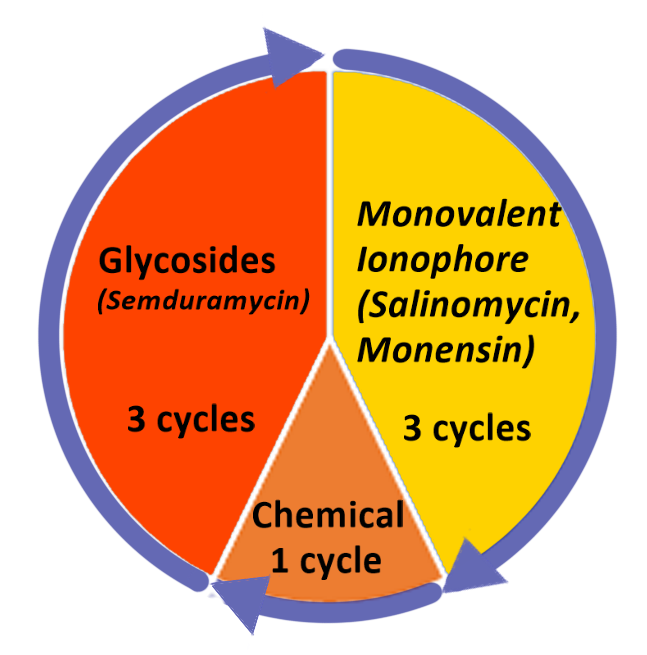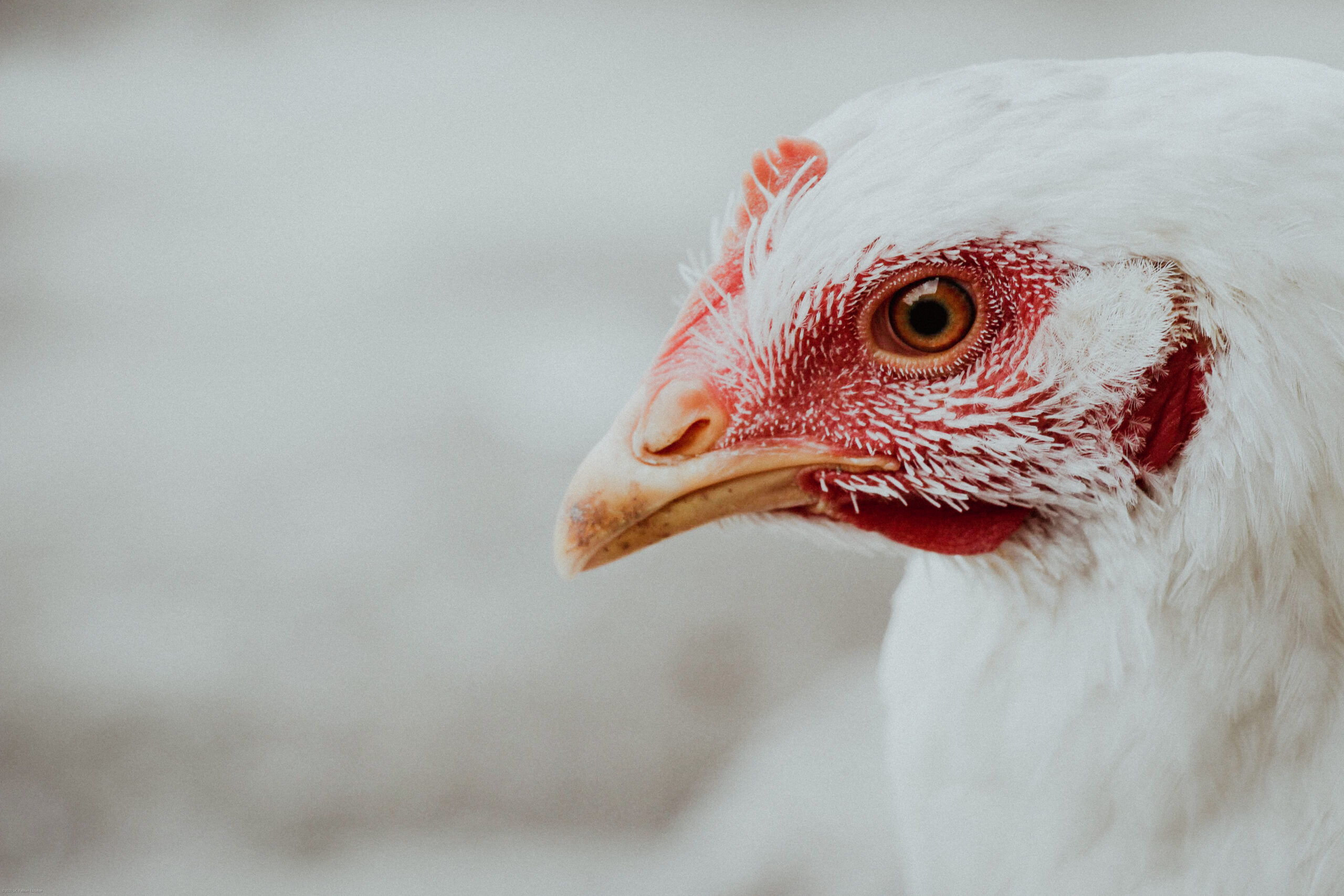In our previous article, we discussed the main species of coccidia affecting broilers, their effect on productivity and health, as well as the basis of prevention. In this article we will analyse prevention in more detail, focusing on the utilisation of coccidiostat products.
Factors determining the occurrence of coccidiosis in poultry
Coccidia are parasites distributed in every poultry enterprise, all around the world. This high prevalence is the result of the intensive conditions under which chickens are currently grown, which increase the chances of these parasites to multiply and produce disease. Therefore, to reduce the impact of these problems, the implementation of preventative measures is essential.
Strategies to prevent the occurrence of coccidiosis in poultry
Prevention is based on three main aspects, namely management, immunisation, and utilisation of anticoccidial drugs (Figure 1).

Figure 1. Components of a coccidiosis prevention program.
Management
One of the main managerial aspects of cocci control is hygiene. Oocysts (environmental stage of the parasite, see previous article) are extremely resistant to disinfectants; therefore, it is very important to mechanically remove faeces and soiling from the poultry house by washing and scrubbing.
Secondly, prolonged downtime periods between flocks do help in reducing the number of oocysts in the environment, decreasing the possibilities of infection. Thirdly, as explained in our previous article, coccidia oocysts need to be exposed to humidity and warm temperatures to become infective. Such conditions are given in dump bedding material, for example near the windows during rains, or when water is spilled below the drinkers. Precautions should be taken to prevent the litter from getting wet (such as proper curtain management in rainy days) and removing wet litter as soon as possible.
Immunisation
Commercial live vaccines can be applied on the first days of the chicks’ life. Such vaccines contain attenuated oocysts of different coccidia species. When administered to the birds, such oocysts multiply in the gastrointestinal tract, inducing immunity without producing major damage in the intestine.
Vaccination against coccidia is very useful to protect long-lived birds, such as replacement pullets and breeder pullets.
However, it is not recommended in broilers since the inflammation and mild damage in the gut following vaccination affects the productive performance of the flock.
Anticoccidial drugs
Anticoccidial drugs, generally known as coccidiostats, are a crucial tool of coccidiosis prevention. They are included in all commercial feeds and, when administered correctly, confer good protection against clinical and subclinical coccidiosis. There are two main groups of coccidiostats, namely ionophores and chemicals (Figure 2). The prolonged use and/or misuse of a coccidiostat may lead to the development of coccidia strains that are resistant to it and to other drugs of similar chemical structure.

Figure 2. Classification of coccidiostats used in poultry production.
Preventing resistance to coccidiostats
When using a coccidiostat to prevent coccidiosis, sooner or later coccidia will develop resistance to it. For products containing an ionophore or a combination of ionophore + chemical, resistance may appear as quickly as 8 months if the same active ingredients have been used continuously. When chemicals are used alone, the time for developing resistance can be as short as 6 to 8 weeks. Since there are no new coccidiostat drugs available in the market, all existing products should be used smartly to maintain their efficacy.
Resistance to coccidiostats can be controlled by creating anticoccidial programs that alternate the use of coccidiostats of different groups. This can be achieved by using some form of rotation or shuttle program.
Rotations (Figure 3) consist of phases in which a given drug is used for a few growth cycles, changing to another drug of very different chemical structure in the following phase, for example from an ionophore to a chemical and vice versa (Figure 3). In each phase of the rotation, all ages receive the same drug. The objective is to eliminate cocci strains that may have already developed resistance to the previous coccidiostat. Products combining an ionophore and a chemical (for example Phibro Aviax Plus) are also helpful to “break resistance”. The length of time a coccidiostat is used depends on its tendency to induce resistance. After a product phase ends, such product may be used again after a lapse of time. Rotations are the usual approach to coccidiostat management followed by commercial feed mills.

Figure 3. Example of a coccidiostat rotation program.
Shuttles are based on alternating two drugs of very different chemical composition in the same growing cycle, for example a chemical in the starter period followed by an ionophore during the grower period. This helps to reduce the development of resistance to both shuttle drugs.
What to consider when designing a coccidiostat program?
• Change the coccidiostat drug periodically, alternating between an ionophore and a chemical.
• After a rotation phase finishes, allow for a sufficient resting period for the used product, as well as any products in the same category/group. For ionophores allow at least 6 months for products in the same class. For chemicals, rest at least 12 to 24 months depending on the product.
• Do not alternate between drugs of similar structure (for example between two monovalent ionophores) since it will not break resistance.
• The combination of a glycoside ionophore (for example Semduramicin) and a chemical (for example nicarbazin) will reduce the chances of developing resistance while lowering the chances of toxicity.
• Always stick to the recommendedinclusion levels to ensure effective control. Too low an inclusion level can lead to coccidiosis challenges and too high an inclusion (in some cases even marginal) may have negative impacts on feed and water intake.
• Apply the withdrawal period for each product to ensure good food safety. Note that withdrawal periods for products with the same active ingredient may differ.
• Some coccidiostats reduce water consumption and should be managed with care or avoided in summer (for example monensin). Other drugs increase water intake and excretion by the chicken which can lead to wet litter, so they should be given with care in wet climate (for example lasalocid).
• Shuttle programs, which include an ionophore in starter feed and a chemical in the grower feed, can also contribute to reduce the development of resistance against coccidiostats.
• If you use commercial feeds, you should consider that each commercial feed mill has its own coccidiostat program. If you would like to change between feed brands, it would be advisable to discuss with the feed mill nutritionist and/ or your veterinary advisor whether the coccidiostat included in the new feed is compatible with the previous coccidiostat program, and whether it fits the epidemiological/ resistance situation at your farm.
As usual, please seek professional (veterinary and/or nutritional) advice before implementing or modifying a coccidiostat program.










Loved reading your article. it was really informational for me. wish to see more in the coming days.
Very interesting article nice one